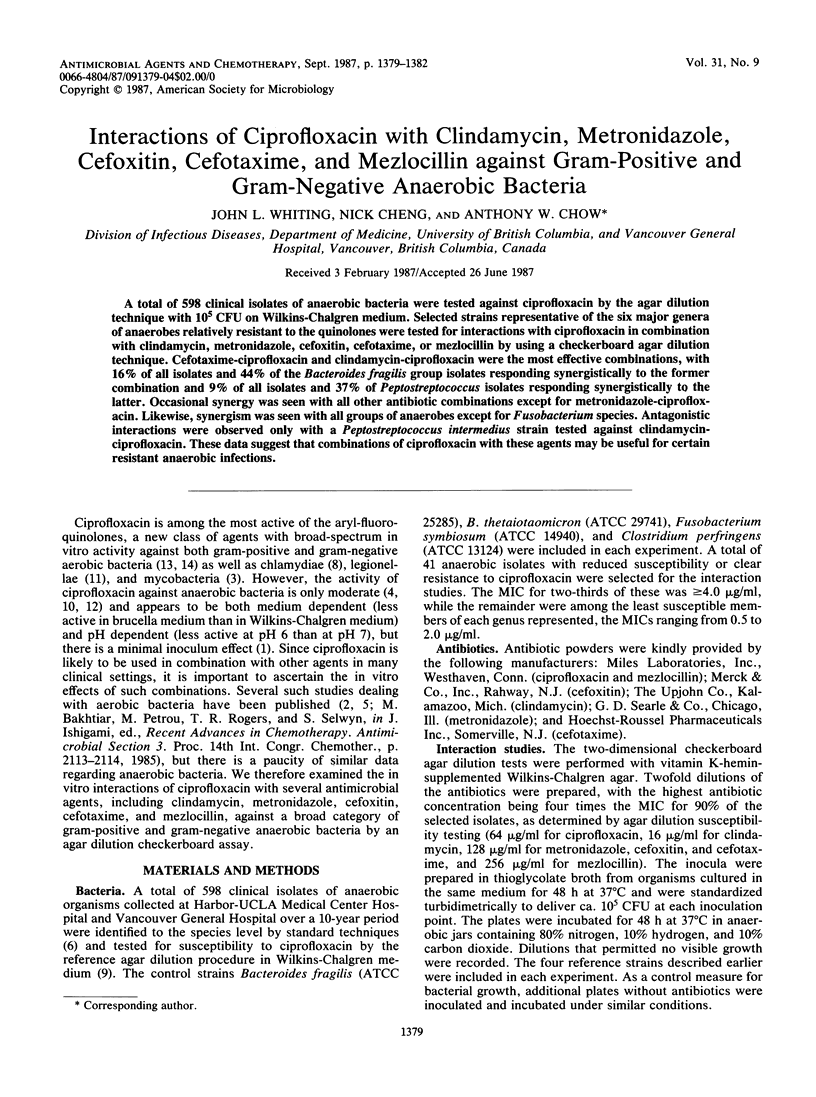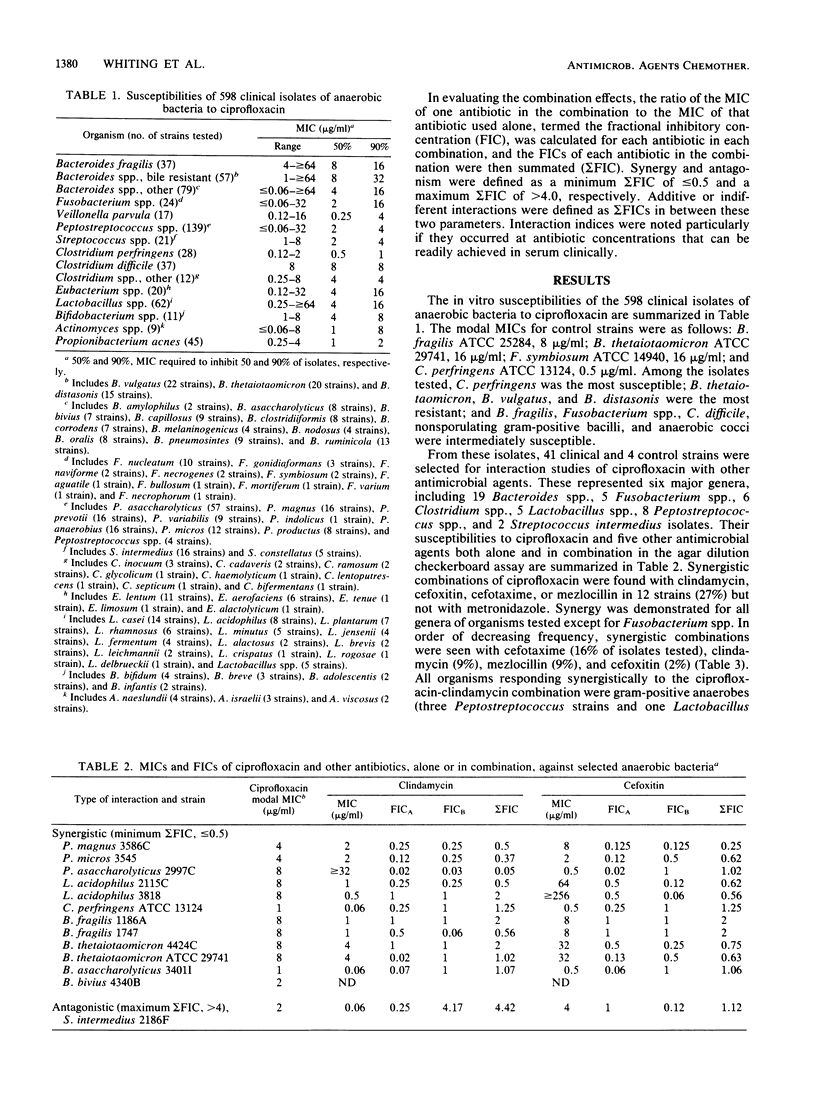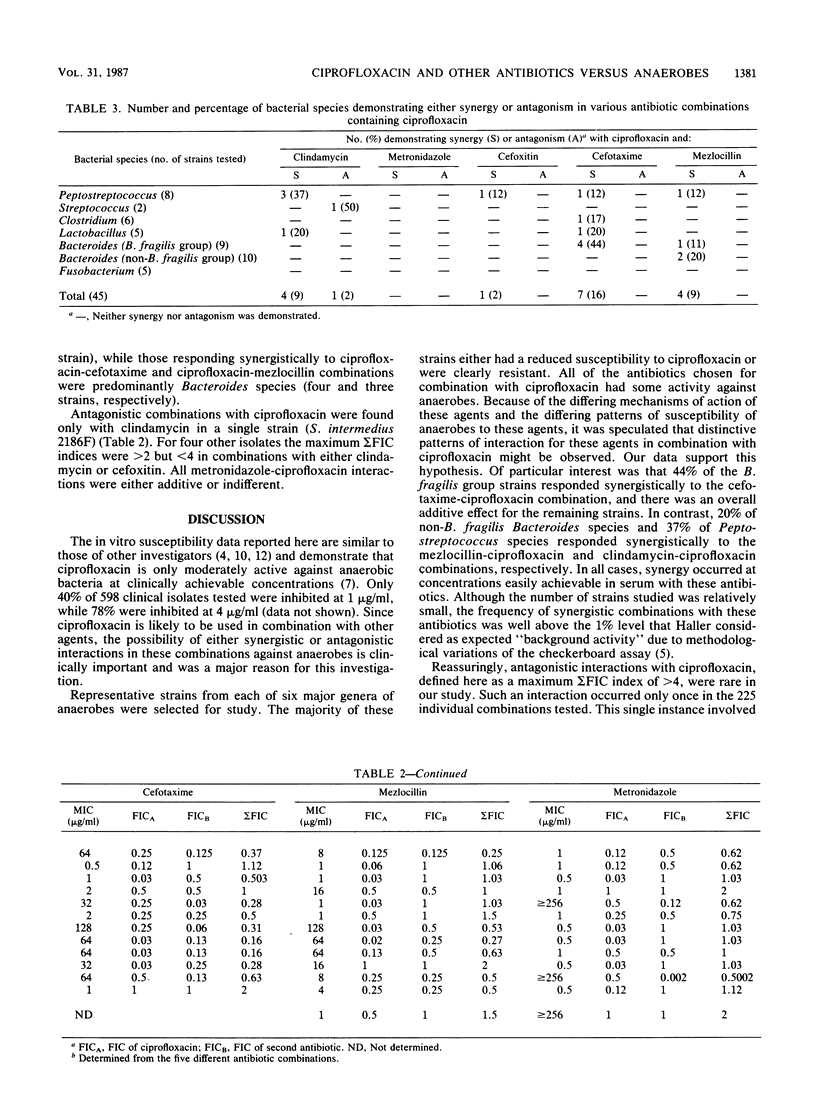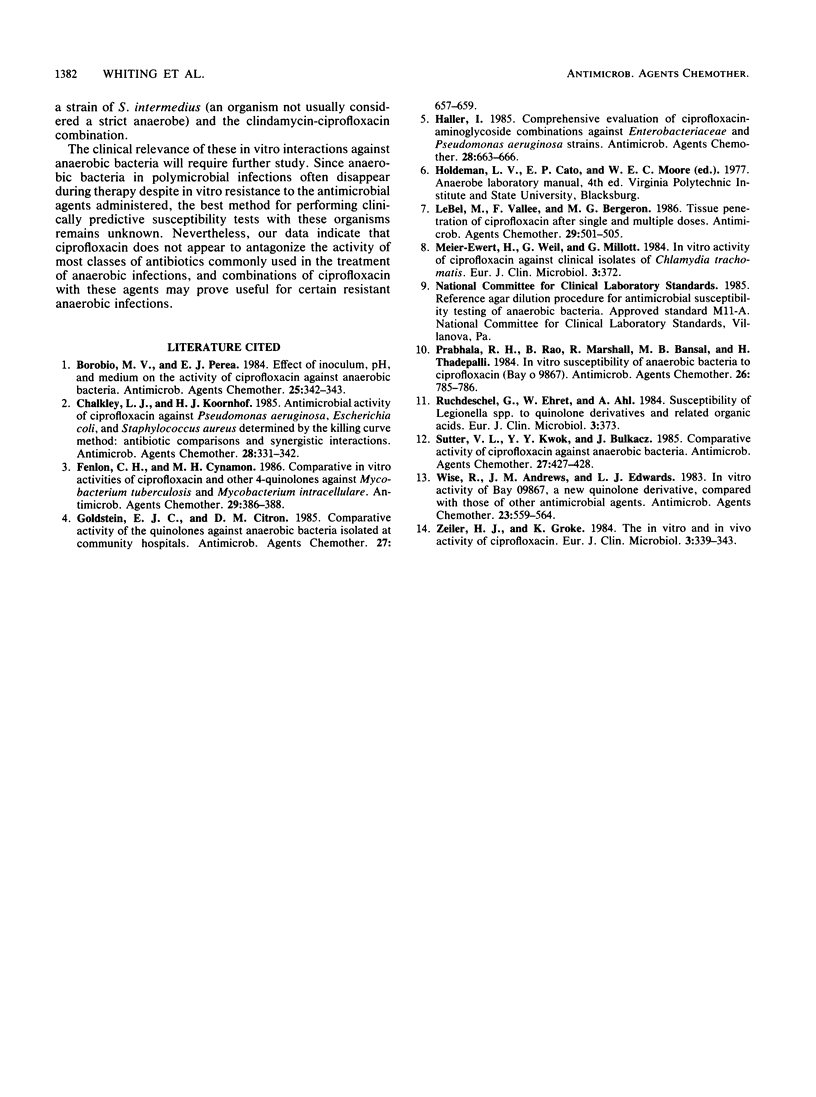Abstract
A total of 598 clinical isolates of anaerobic bacteria were tested against ciprofloxacin by the agar dilution technique with 10(5) CFU on Wilkins-Chalgren medium. Selected strains representative of the six major genera of anaerobes relatively resistant to the quinolones were tested for interactions with ciprofloxacin in combination with clindamycin, metronidazole, cefoxitin, cefotaxime, or mezlocillin by using a checkerboard agar dilution technique. Cefotaxime-ciprofloxacin and clindamycin-ciprofloxacin were the most effective combinations, with 16% of all isolates and 44% of the Bacteroides fragilis group isolates responding synergistically to the former combination and 9% of all isolates and 37% of Peptostreptococcus isolates responding synergistically to the latter. Occasional synergy was seen with all other antibiotic combinations except for metronidazole-ciprofloxacin. Likewise, synergism was seen with all groups of anaerobes except for Fusobacterium species. Antagonistic interactions were observed only with a Peptostreptococcus intermedius strain tested against clindamycin-ciprofloxacin. These data suggest that combinations of ciprofloxacin with these agents may be useful for certain resistant anaerobic infections.
Full text
PDF



Selected References
These references are in PubMed. This may not be the complete list of references from this article.
- Borobio M. V., Perea E. J. Effect of inoculum, pH, and medium on the activity of ciprofloxacin against anaerobic bacteria. Antimicrob Agents Chemother. 1984 Mar;25(3):342–343. doi: 10.1128/aac.25.3.342. [DOI] [PMC free article] [PubMed] [Google Scholar]
- Chalkley L. J., Koornhof H. J. Antimicrobial activity of ciprofloxacin against Pseudomonas aeruginosa, Escherichia coli, and Staphylococcus aureus determined by the killing curve method: antibiotic comparisons and synergistic interactions. Antimicrob Agents Chemother. 1985 Aug;28(2):331–342. doi: 10.1128/aac.28.2.331. [DOI] [PMC free article] [PubMed] [Google Scholar]
- Fenlon C. H., Cynamon M. H. Comparative in vitro activities of ciprofloxacin and other 4-quinolones against Mycobacterium tuberculosis and Mycobacterium intracellulare. Antimicrob Agents Chemother. 1986 Mar;29(3):386–388. doi: 10.1128/aac.29.3.386. [DOI] [PMC free article] [PubMed] [Google Scholar]
- Goldstein E. J., Citron D. M. Comparative activity of the quinolones against anaerobic bacteria isolated at community hospitals. Antimicrob Agents Chemother. 1985 Apr;27(4):657–659. doi: 10.1128/aac.27.4.657. [DOI] [PMC free article] [PubMed] [Google Scholar]
- Haller I. Comprehensive evaluation of ciprofloxacin-aminoglycoside combinations against Enterobacteriaceae and Pseudomonas aeruginosa strains. Antimicrob Agents Chemother. 1985 Nov;28(5):663–666. doi: 10.1128/aac.28.5.663. [DOI] [PMC free article] [PubMed] [Google Scholar]
- LeBel M., Vallée F., Bergeron M. G. Tissue penetration of ciprofloxacin after single and multiple doses. Antimicrob Agents Chemother. 1986 Mar;29(3):501–505. doi: 10.1128/aac.29.3.501. [DOI] [PMC free article] [PubMed] [Google Scholar]
- Meier-Ewert H., Weil G., Millott G. In vitro activity of ciprofloxacin against clinical isolates of Chlamydia trachomatis. Eur J Clin Microbiol. 1984 Aug;3(4):372–372. doi: 10.1007/BF01977501. [DOI] [PubMed] [Google Scholar]
- Prabhala R. H., Rao B., Marshall R., Bansal M. B., Thadepalli H. In vitro susceptibility of anaerobic bacteria to ciprofloxacin (Bay o 9867). Antimicrob Agents Chemother. 1984 Nov;26(5):785–786. doi: 10.1128/aac.26.5.785. [DOI] [PMC free article] [PubMed] [Google Scholar]
- Ruckdeschel G., Ehret W., Ahl A. Susceptibility of Legionella spp. to quinolone derivatives and related organic acids. Eur J Clin Microbiol. 1984 Aug;3(4):373–373. doi: 10.1007/BF01977502. [DOI] [PubMed] [Google Scholar]
- Sutter V. L., Kwok Y. Y., Bulkacz J. Comparative activity of ciprofloxacin against anaerobic bacteria. Antimicrob Agents Chemother. 1985 Mar;27(3):427–428. doi: 10.1128/aac.27.3.427. [DOI] [PMC free article] [PubMed] [Google Scholar]
- Wise R., Andrews J. M., Edwards L. J. In vitro activity of Bay 09867, a new quinoline derivative, compared with those of other antimicrobial agents. Antimicrob Agents Chemother. 1983 Apr;23(4):559–564. doi: 10.1128/aac.23.4.559. [DOI] [PMC free article] [PubMed] [Google Scholar]
- Zeiler H. J., Grohe K. The in vitro and in vivo activity of ciprofloxacin. Eur J Clin Microbiol. 1984 Aug;3(4):339–343. doi: 10.1007/BF01977490. [DOI] [PubMed] [Google Scholar]


